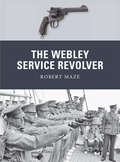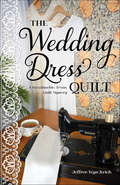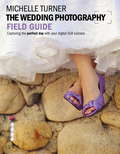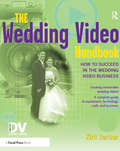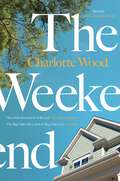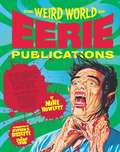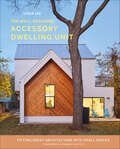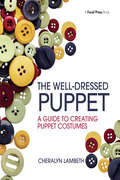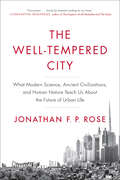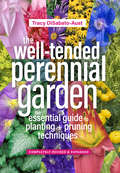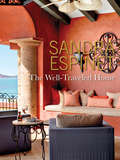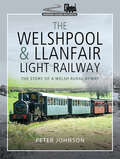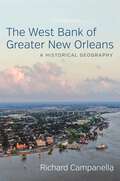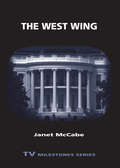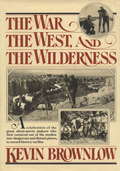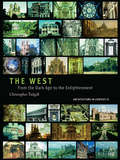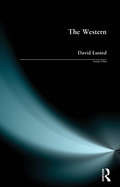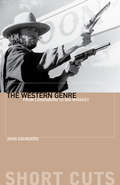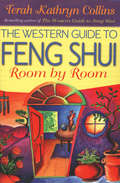- Table View
- List View
The Weber Street Wonder Work Crew
by Maxwell NewhouseFor some families, part-time jobs for children are a way to impart all kinds of skills and experience. For others, it&’s a matter of necessity if kids want spending money. Maxwell Newhouse, who is a plumber as well as an author and artist, understands this. The Weber Street Wonder Work Crew is a group of kids who have lots to offer their neighbors: from babysitting cranky toddlers to lending a hand in a garden, washing windows, and even helping an elderly lady who needs support to keep up with her friends online.Lively folk-style paintings work with a simple text to inspire kids to take part in their own communities.
The Webley Service Revolver
by Peter Dennis Robert MazeThe Webley .455in service revolver is among the most powerful top-break revolvers ever produced and has a claim to be the first 'tactical fighting pistol'. First adopted in 1887, in various marques it was the standard-issue service pistol for British and Commonwealth armed forces for nearly fifty years; later versions in .38in calibre went on to see further service in World War II and beyond, as well as in a host of law-enforcement roles around the world into the 1970s.Developed to give British service personnel the ability to incapacitate their opponents in 'small wars' around the globe, the Webley used the formidable - and controversial - .455in cartridge, a variant of which was known as the 'manstopper'. Users found it offered good penetration and excellent stopping power with only mild recoil - indeed, it was rated superior to the US .45 Colt in stopping power.Featuring specially commissioned full-colour artwork and close-up photographs, this is the compelling story of the Webley revolver, the powerful pistol that saw service across the British Empire and throughout two world wars.
The Wedding Dress Quilt: A Waxahachie, Texas, Quilt Mystery
by Jeffree Wyn ItrichFamily secrets, a second chance at love, and a stalker—trouble is right around the corner. Adopted as an infant, art quilter Lisbeth James has no clue about the family waiting for her. After her maternal grandmother dies, Lisbeth inherits the family home and travels to Texas to claim her inheritance. There, she finds long-lost family, a man who makes her heart flutter, a feeling she has not known since the passing of her ex-fiancé, and a hidden treasure—a stunning wedding dress— that inspires her to make a double wedding ring quilt. Yet beneath the newfound joy, she discovers a stalker and pieces of her past, she senses foul play in her ex-fiancé’s seemingly accidental death. Weaves timeless themes cherished by readers of all ages: second chances, finding family, and new love The relatable main character, an avid quilter, stumbles upon her mother’s unworn wedding dress, inspiring her to create an extraordinary, prize-winning double wedding ring quilt. The main character confronts her deepest fears, embraces life-altering challenges, and uncovers the darkness that follows her to a small town in Texas.
The Wedding Photography Field Guide: Capturing The Perfect Day With Your Digital Slr (Field Guide Ser.)
by Michelle TurnerAt any wedding you attend, you will not only see the professional photographer, but a host of the happy couple's friends and family, cameras in hand, all looking to capture the definitive shot of the perfect day. <P><P> The portability and adaptability of digital photography has opened up the world of wedding shooting; however, on such a special occasion it's vital that the photographer is confident that he or she is up to the job. The Wedding Photography Field Guide-although compact enough to fit easily into a suit pocket-offers comprehensive and easy-to-follow advice on how to do the special day justice. Whether it's dimly lit churches or lively dance floors, wedding photography presents particular and demanding locations, and you rarely have much time to shoot. All the situations you're likely to encounter are covered here, along with advice on the best equipment, posing, people-management, and technique. The book also explores different styles of wedding photography, from the classic formal portrait to modern reportage approaches, with inspirational shots from leaders in the field.
The Wedding Photography Field Guide: Capturing the Perfect Day with your Camera (Field Guide Ser.)
by Michelle TurnerLong gone are the days of lining up the wedding party for predictable and overly-staged group shots. Now more than ever, couples want to remember their wedding day - and the run up to it - with candid, photojournalistic-style photos and innovatively-designed albums.The Wedding Photography Field Guide is a source of inspiration and illumination, and sets out how to capture the true essence and atmosphere of this emotionally-charged and very special day.- Get the latest information on digital gear and a professional's take on top techniques for covering all the action.- Stuffy, staged wedding photos are a thing of the past. Master modern wedding reportage and capture the true spirit of the event and the personalities of the couple and guests.- Discover the secrets of creating uniquely personal and contemporary bridal portraits and albums.- Don't get left behind in this competitive marketplace. Follow Michelle Turner's advice and build up a portfolio that can pack a punch.- Whether you are simply shooting a friend's wedding, breaking into the business or looking to refresh your approach, this book is essential.
The Wedding Video Handbook: How to Succeed in the Wedding Video Business
by Kirk BarberFor readers who want to become part of the thriving wedding video industry, Wedding Video Handbook explains everything a wedding videographer needs to know. Each chapter explores a different part of either the business or the production ends, and covers topics including secrets for getting clients, selecting the proper equipment, and tips on capturing special wedding moments despite difficult filming conditions. The book includes handy primers on marketing and advertising, handling phone calls and appointments, pre-production preparations, what to shoot on the wedding day, interacting with other vendors, editing and packaging the DVD or video, and generating referrals. Fully up-to-date with information on the newest tools and equipment used in this rapidly-evolving market as well as the cutting-edge trends in wedding video products, Wedding Video Handbook is packed with practical advice from a pro who has spent years in the field.
The Weekend Woodworker's Project Collection: 40 Projects for the Time-Challenged Craftsman
by Editors of Popular WoodworkingPick a Project, Finish It in a WeekendDo you have time only during weekends to immerse yourself in your woodworking? If so, then The Weekend Woodworker's Project Collection is for you. This book has 40 projects from which to choose and, depending on the level of your woodworking skills, any of them can be completed in one or two weekends.Projects include:a game boxa jewelry boxseveral styles of bookcases and shelves5 mirror/picture framesand moreAnd, you can choose from Arts and Crafts, Chippendale, Shaker, Federal, Contemporary, Greene & Greene or American Country furniture styles. So, pick a project and get started-time's a wastin'!
The Weekend: An unforgettable story of female friendship by the bestselling author of the Booker Prize-shortlisted Stone Yard Devotional
by Charlotte Wood'So great I am struggling to find the words to do it justice' Marian KeyesA Book of the Year for The Times, Observer, Independent and Good Housekeeping'A rare pleasure' Sunday Times'Riveting' Elizabeth Day'A perfect, funny, insightful, novel about women, friendship, and ageing' Nina Stibbe'A lovely, lively, intelligent, funny book' Tessa Hadley'Glorious . . . Charlotte Wood joins the ranks of writers such as Nora Ephron, Penelope Lively and Elizabeth Strout' GuardianSylvie, Jude, Wendy and Adele have been friends for decades, but when Sylvie dies, the ground shifts dangerously for the remaining three.These women couldn't be more different: Jude, a once-famous restaurateur with a long-standing affair with a married man; Wendy, an acclaimed feminist intellectual; Adele, a former star of the stage, now practically homeless. Struggling to recall exactly why they've remained close all these years, the grieving women gather for one last weekend at Sylvie's old beach house. But fraying tempers, an elderly dog, unwelcome guests and too much wine collide in a storm that threatens to sweep away their friendship for good.
The Weird World of Eerie Publications
by Stephen R. Bissette Mike HowlettEerie Publications' horror magazines brought blood and bad taste to America's newsstands from 1965 through 1975. Ultra-gory covers and bottom-of-the-barrel production values lent an air of danger to every issue, daring you to look at (and purchase) them.The Weird of World of Eerie Publications introduces the reader to Myron Fass, the gun-toting megalomaniac publisher who, with tyranny and glee, made a career of fishing pocketbook change from young readers with the most insidious sort of exploitation. You'll also meet Carl Burgos, who, as editor of Eerie Publications, ground his axe against the entire comics industry. Slumming comic art greats and unknown hacks were both employed by Eerie to plagiarize the more inspired work of pre-Code comic art of the 1950s.Somehow these lowbrow abominations influenced a generation of artists who proudly blame career choices (and mental problems) on Eerie Publications. One of them, Stephen R. Bissette (Swamp Thing, Taboo, Tyrant), provides the introduction for this volume.Here's the sordid background behind this mysterious comics publisher, featuring astonishingly red reproductions of many covers and the most spectacularly creepy art.
The Well-Designed Accessory Dwelling Unit: Fitting Great Architecture into Small Spaces
by Lydia LeeAn inspirational look book for conceiving, planning, and building an accessory dwelling unit (ADU), a small house that is on the same property as the main house—a quickly growing trend that is transforming our vision of what a dream home should be. ADUs offer homeowners opportunities to host family and friends, add studio or office space, or generate passive income through a long-term rental on their existing property. Combine these practical benefits with broad and preferential rezoning in many municipalities throughout the US, and ADUs are one of the biggest developments in housing. Written by award-winning architecture and design writer Lydia Lee, this thoughtful exploration of ADUs answers many of the questions that arise when thinking about investing in an ADU. From design strategies and challenges to understanding zoning regulations to financing and material selection, this title covers the need-to-know basics on ADUs in addition to presenting expert advice from architects, builders, and homeowners. Accompanying this information are extensive looks at 15 carefully designed ADUs from the US and Canada, complete with showstopping photos, floor plans, and informative text boxes. Readers will learn unique perspectives from each project including green building solutions, practical architectural solutions to optimize limited space, and the pitfalls homeowners encountered and resolved. Content includes • insights shared by architects and ADU owners from 15 projects in the US and Canada; • floor plans and high-end interior and exterior project photography; • discussion of prefabricated materials, green building, and storage solutions; and • a primer on zoning, financing, building, and more. With so many possibilities and opportunities for ADUs, this book is ideal for homeowners, architects, interior designers, builders, and developers.
The Well-Dressed Puppet: A Guide to Creating Puppet Costumes
by Cheralyn LambethCostumes are an integral part of any performance, adding believability, conveying setting, or establishing the tone, a fact that is no less true when your performer is a puppet! The only book of its kind, The Well-Dressed Puppet will show you how to create costumes and accessories tailored specifically for your puppet that will enhance any performance. Gone are the days of ill-fitting store-bought clothing that restrict the movement and use of your puppet. Author Cheralyn Lambeth walks you through every step of the costume-making process with detailed lists of the necessary materials, equipment, and patterns required to create a costume from scratch. She also shares multiple tips and information on how to modify off-the-rack clothing to fit any puppet. Suitable for both beginners and more advanced costumers, The Well-Dressed Puppet demonstrates basic sewing and construction techniques while still providing advanced projects for customers who have already mastered those skills.
The Well-Tempered City: What Modern Science, Ancient Civilizations, and Human Nature Teach Us About the Future of Urban Life
by Jonathan F. Rose“A thorough education in how to move from simply maximizing the economic output of cities to improving the well-being of all urban residents.” —Daniel L. Doctoroff, CEO, Sidewalk Labs2017 PROSE Award Winner: Outstanding Scholarly Work by a Trade Publisher Cities are birthplaces of civilization; centers of culture, trade, and progress; cauldrons of opportunity—and the home of eighty percent of the world’s population by 2050. As the twenty-first century progresses, metropolitan areas will bear the brunt of global megatrends such as climate change, natural resource depletion, population growth, income inequality, mass migrations, education and health disparities, among many others. In The Well-Tempered City, Jonathan F. P. Rose—the man who “repairs the fabric of cities”—distills a lifetime of interdisciplinary research and firsthand experience into a five-pronged model for how to design and reshape our cities with the goal of equalizing their landscape of opportunity. Drawing from the musical concept of “temperament” as a way to achieve harmony, Rose argues that well-tempered cities can be infused with systems that bend the arc of their development toward equality, resilience, adaptability, well-being, and the ever-unfolding harmony between civilization and nature. These goals may never be fully achieved, but our cities will be richer and happier if we aspire to them, and if we infuse our every plan and constructive step with this intention. A celebration of the city and an impassioned argument for its role in addressing the important issues in these volatile times, The Well-Tempered City is a reasoned, hopeful blueprint for a thriving metropolis—and the future.“A thought-provoking introduction to the future of cities.” —Publishers Weekly
The Well-Tended Perennial Garden: The Essential Guide to Planting and Pruning Techniques, Third Edition
by Tracy DiSabato-Aust“This practical guide is lush with clear, step-by-step advice.” —Real Simple Since its original publication twenty years ago, The Well-Tended Perennial Garden has helped home gardeners successfully plan, plant, and tend their gardens. Now Tracy Di-Sabato-Aust’s trusty advice and reassuring tone are back and better than ever in this completely revised new edition. Novice and experienced gardeners alike will benefit from Tracy’s thorough details on the essential practices of perennial care—included deadheading, pinching, and thinning—along with growing information for new species and cultivars, on-trend garden design advice, a monthly planting and maintenance schedule, and details on native plants and gardening for wildlife. The Well-Tended Perennial Garden is a must-have ally in the quest for a beautiful, well-maintained garden.
The Well-Traveled Home
by Sandra EspinetLuxury homes with international panache—includes over 175 exquisite photos.Sandra Espinet&’s extensive world travels produce finds of exquisitely wrought artisanal furniture, dramatic artworks, and exotic accessories that are put to beautiful use in interiors. Blending the fabulous objects culled from particular corners of the globe is a delicate art form. Well-known to viewers of HGTV, Espinet is a mix-master of eclectic convergence, a specialist in the fearless melding of exotic elements with traditional furnishings into stylish and unforgettable presentations of comfort and calm, exhilaration and extravagance. This gorgeous book showcases her unique knack for incorporating international treasures into alluring domestic living spaces.
The Welshpool & Llanfair Light Railway: The Story of a Welsh Rural Byway (Narrow Gauge Railways)
by Peter Johnson“A superb book . . . about the background to the railway, its development and closure and the relaunch into one of Wales’ most pleasant preserved railways.” —The Railway Correspondence and Travel SocietyUnusually among Welsh narrow-gauge railways, the 2ft 6in gauge Welshpool & Llanfair Light Railway was built to benefit agriculture, not minerals. After several failed attempts to connect the market town at Welshpool with the rural community around Llanfair Caereinion, the 1896 Light Railways Act paved the way for the railway which opened in 1902.Operated by the Cambrian Railways and then by the Great Western Railway, it became the only narrow-gauge steam railway catering for goods traffic under the auspices of British Railways. Sadly, it was closed in 1956 but enthusiasts ensured its revival, which started in 1963.Overcoming many obstacles, the railway is now run by a charitable trust and is a leading volunteer-operated tourist attraction in Montgomeryshire.“As is to be expected by the pre-eminent authority on Welsh narrow gauge and minor railways, this is a work of first-class research, but also one of much interest . . . I have no hesitation in recommending it, especially for anyone interested in narrow gauge or indeed preserved railways.” —The Journal of the Friends of the National Railway Museum “A worthwhile addition to the published material on this delightful railway, and likely to prompt even more interest amongst modellers.” —Railway Modeller“Whether it is a line you know well or not, if you like narrow gauge or minor railways then I am sure you will enjoy this book.” —Michael’s Model Railways
The Welshpool & Llanfair Light Railway: The Story of a Welsh Rural Byway (Narrow Gauge Railways)
by Peter Johnson“A superb book . . . about the background to the railway, its development and closure and the relaunch into one of Wales’ most pleasant preserved railways.” —The Railway Correspondence and Travel SocietyUnusually among Welsh narrow-gauge railways, the 2ft 6in gauge Welshpool & Llanfair Light Railway was built to benefit agriculture, not minerals. After several failed attempts to connect the market town at Welshpool with the rural community around Llanfair Caereinion, the 1896 Light Railways Act paved the way for the railway which opened in 1902.Operated by the Cambrian Railways and then by the Great Western Railway, it became the only narrow-gauge steam railway catering for goods traffic under the auspices of British Railways. Sadly, it was closed in 1956 but enthusiasts ensured its revival, which started in 1963.Overcoming many obstacles, the railway is now run by a charitable trust and is a leading volunteer-operated tourist attraction in Montgomeryshire.“As is to be expected by the pre-eminent authority on Welsh narrow gauge and minor railways, this is a work of first-class research, but also one of much interest . . . I have no hesitation in recommending it, especially for anyone interested in narrow gauge or indeed preserved railways.” —The Journal of the Friends of the National Railway Museum “A worthwhile addition to the published material on this delightful railway, and likely to prompt even more interest amongst modellers.” —Railway Modeller“Whether it is a line you know well or not, if you like narrow gauge or minor railways then I am sure you will enjoy this book.” —Michael’s Model Railways
The Wes Anderson Collection (The Wes Anderson Collection)
by Michael Chabon Eric Anderson Max Dalton Matt SeitzThis New York Times bestselling overview of Wes Anderson's filmography features previously unpublished behind-the-scenes photos, artwork, and ephemera, with an introduction by Michael Chabon. Writer/director Wes Anderson guides movie/television critic Matt Zoller Seitz through Anderson's life and career in a hardcover book-length conversation, woven together with original illustrations and production images fromBottle Rocket, Rushmore, The Royal Tenenbaums, The Life Aquatic with Steve Zissou,The Darjeeling Limited, Fantastic Mr. Fox, and Moonrise Kingdom. The result is a meticulously desiged book that captures and reflects the spirit of Wes Anderson's movies: melancholy, playful, wise, and wonderfully unique.
The West Bank of Greater New Orleans: A Historical Geography
by Richard CampanellaThe West Bank has been a vital part of greater New Orleans since the city’s inception, serving as its breadbasket, foundry, shipbuilder, railroad terminal, train manufacturer, and even livestock hub. At one time it was the Gulf South’s St. Louis, boasting a diversified industrial sector as well as a riverine, mercantilist, and agricultural economy. Today the mostly suburban West Bank is proud but not pretentious, pleasant if not prominent, and a distinct, affordable alternative to the more famous neighborhoods of the East Bank. Richard Campanella is the first to examine the West Bank holistically, as a legitimate subregion with its own story to tell. No other part of greater New Orleans has more diverse yet deeply rooted populations: folks who speak in local accents, who exhibit longstanding cultural traits, and, in some cases, who maintain family ownership of lands held since antebellum times—even as immigrants settle here in growing numbers. Campanella demonstrates that West Bankers have had great agency in their own place-making, and he challenges the notion that their story is subsidiary to a more important narrative across the river. The West Bank of Greater New Orleans is not a traditional history, nor a cultural history, but rather a historical geography, a spatial explanation of how the West Bank’s landscape formed: its terrain, environment, land use, jurisdictions, waterways, industries, infrastructure, neighborhoods, and settlement patterns, past and present. The book explores the drivers, conditions, and power structures behind those landscape transformations, using custom maps, aerial images, photographic montages, and a detailed historical timeline to help tell that complex geographical story. As Campanella shows, there is no “greater New Orleans” without its cross-river component. The West Bank is an essential part of this remarkable metropolis.
The West Wing (TV Milestones)
by Janet MccabeWith its fast and furious dialogue, crackling wit, and political savvy, The West Wing became appointment TV for millions during its seven-season run between 1999 and 2006. The behind-the-scenes ensemble drama about Washington politics premiered on the wake of the Monica Lewinsky scandal, was the first series to respond to the 9/11 terrorist attacks, and concluded in the closing years of the Bush administration. Its subject matter was ambitious and germane, its cast star-studded, its production team acclaimed. In this volume, Janet McCabe explores The West Wing as both a space for political and social discourse and a force that reshaped contemporary television. McCabe begins by examining the series' broadcasting history, including its scheduling in the United States and around the world, and how the show defines channels and television markets. McCabe goes on to explore the role of the show's creator Aaron Sorkin as a TV auteur and investigates the program's aesthetic principles, including the distinctive look, feel, and sounds of the series. McCabe concludes by considering the political discourse of The West Wing, as the show spoke back to a U.S. culture divided by politics, race, and gender as well as the trauma of 9/11 and anxieties over terrorism and the wars in Iraq and Afghanistan. McCabe's analysis of The West Wing provides an intriguing look at the institutional, formal, and cultural politics of television. Fans of the series as well as students and teachers of television history will enjoy this detailed volume.
The West Wing and Beyond: What I Saw Inside the Presidency
by Pete SouzaGo behind the scenes of the West Wing—into the Oval Office and Situation Room, aboard Air Force One, and beyond—with #1 bestselling author and former presidential photographer Pete Souza. Pete Souza has spent more time in the Oval Office than almost any person in history. During the Obama administration alone, Souza was inside the presidential bubble for more than 25,000 hours and made nearly 2 million photographs. The result is an unprecedented view of how our democracy really works. Now Souza invites you into the inner sanctum of the American presidency, sharing rarely seen photographs and untold stories of life and work in the White House and traveling with the President around the world. The West Wing and Beyond takes you behind the scenes of consequential moments and traditions with the people who define our nation&’s highest office—from the senior White House staff to the Oval Office valets. It delivers new insights into the role of the Secret Service, the seriousness of decisive meetings in the West Wing, and even some fun moments aboard Air Force One. Brimming with gorgeous photographs paired with fascinating storytelling, The West Wing and Beyond offers a one-of-a-kind look into the personalities, intrigues, and fascinating details that comprise the modern presidency. It is an essential book for every citizen who believes in American democracy.
The West, The War, and The Wilderness
by Kevin BrownlowHere, from one of today's leading authorities on film history, is the story, told brilliantly and for the first time, of the pioneering movie makers who as early as 1905 traveled beyond the studio stages to make feature films on location--and in so doing recorded the real history and real life of their time. The War, the West, and the Wilderness is the result of more than a decade of passionate research by Kevin Brownlow, whose last book, The Parade's Gone By... (hailed by Charles Champlin as "the definitive work on the silent era") is regarded as a classic history of early motion pictures. His new book is alive with the voices of the film-makers themselves, in their logbooks, in their letters and diaries, in their firsthand accounts of their adventurous journeys and cinematic innovations, and--even more immediate--in Brownlow's interviews with cameramen, director's, lighting technicians, and actors who relive those days, taking us with them to the Great War, to the West, ad into the Wilderness. It is the triumph of this book to reconstruct the dramatic moments when these men and women contrived, against ordinary odds, to bring to movie audiences for the first time, the look, the feel--the actuality--of large events and distant places, from the great battles of World War I to the South Seas with Jack London aboard the Shark, and the gold rush in Tonopah, Nevada.
The West: From the Advent of Christendom to the Eve of Reformation (History Of Architecture Ser.)
by Christopher TadgellChristopher Tadgell covers the major architectural traditions of the Middle Ages, from the Romanesque architecture of the ninth and tenth centuries, built on the legacy of ancient Rome and including elements from Carolingian, Ottonian, Byzantine and northern European traditions, through to the evolution of the Gothic which heralded new, structurally daring architecture. The book ends with the Italian rediscovery of classical ideas and ideals and the emergence of the great Renaissance theorists and architects, including Brunelleschi, Alberti, and Bramante. As well as the palazzos, villas and churches of Renaissance Italy, this period saw the building of great chateaux in France, palaces in Germany and the golden-domed cathedrals of Russia. With more than two thousand images, including many plans, The West is a beautiful, single-volume guide to the history of architecture in this period, covering the whole of Europe from Ireland to Russia and placing architectural developments within their political, technological, artistic and intellectual contexts.
The Western (Inside Film)
by David LustedThe Western introduces the novice to the pleasures and the meanings of the Western film, shares the excitement of the genre with the fan, addresses the suspicions of the cynic and develops the knowledge of the student. The Western is about the changing times of the Western, and about how it has been understood in film criticism. Until the 1980s, more Westerns were made than any other type of film. For fifty of those years, the genre was central to Hollywood's popularity and profitability. The Western explores the reasons for its success and its latter-day decline among film-makers and audiences alike. Part I charts the history of the Western film and its role in film studies. Part II traces the origins of the Western in nineteenth-century America, and in its literary, theatrical and visual imagining. This sets the scene to explore the many evolving forms in successive chapters on early silent Westerns, the series Western, the epic, the romance, the dystopian, the elegiac and, finally, the revisionist Western. The Western concludes with an extensive bibliography, filmography and select further reading. Over 200 Westerns are discussed, among them close accounts of classics such as Duel in the Sun, The Wild Bunch and Unforgiven, formative titles like John Ford's epic The Iron Horse, and early cowboy star William S. Hart's The Silent One together with less familiar titles that deserve wider recognition, including Comanche Station, Pursued and Ulzana's Raid.
The Western Genre: From Lordsburg to Big Whiskey (Short Cuts)
by John SaundersThe Western Genre: From Lordsburg to Big Whiskey offers close readings of the definitive American film movement as represented by such leading exponents as John Ford, Howard Hawks, and Sam Peckinpah. In his consideration of such iconic motifs as the Outlaw Hero and the Lone Rider, John Saunders traces the development of perennial aspects of the genre, its continuity and, importantly, its change. Representations of morality and masculinity are also foregrounded in consideration of the genre's major stars John Wayne and Clint Eastwood, and such films as Shane, Rio Bravo, The Wild Bunch, and Unforgiven.
The Western Guide to Feng Shui: Room By Room
by Terah Kathryn CollinsFilled with photographs, stories, and many practical Feng Shui "tricks of the trade," this book is packed with ideas and tools that you can easily apply to your life to increase your prosperity and improve your health, creativity, and overall happiness. Terah covers every room in great detail—including your living room, dining room, bedrooms and bathrooms, home office, kitchen, family room, and storage areas. She also explores the attitudinal and spiritual work—the inner Feng Shui—that complements and strengthens your outer Feng Shui enhancements. Includes a 16-page insert of color photos to emphasize the author’s points.

